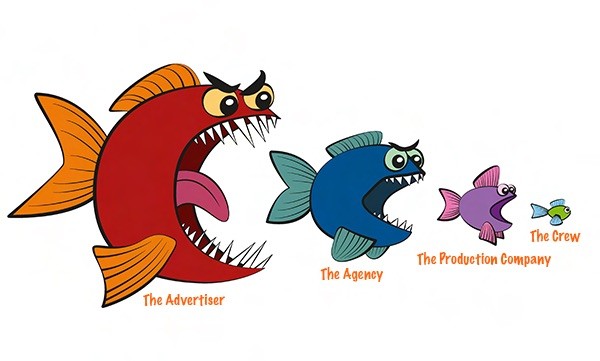Living in a post truth world full of alternative facts and fake news may seem like a recent occurrence to some. But a real fact is that in advertising broadcast production there have been alternative facts for many years that survive the test of time and are perpetuated from one generation of agency producer to the next.
These alternative facts assist the agency from having to address the issues that plague the production category and alleviate the advertiser from ever having to worry about taking action to close the loopholes these alternative facts obscure. Loop holes that allow the agency and production house to operate without accountability and at an increased margin at the advertiser’s expense. Here are a couple of these alternative facts and their implications from the many that shroud the advertising production category.
Alternative Fact #1 – The Production Company Contract
There are many alternative facts that get quoted as industry standards in the production industry, and they usually involve what is touted as the industry standard contract. A classic example in Australia is the SPAA (Screen Producers Association of Australia) agreement.
This is often claimed by agency producers to be the only, official and legally recognised contract between the production house and the agency / advertiser when signing off the official engagement of a production house. This usually involves an up front payment of 50% of the agreed upon fee for the production of the TV commercial.
So let’s be honest here, the SPAA contract is not the only contract out there, there is also the Communications Council contract or individual contracts drafted by singular production houses (like the Master Services Agreement created by Tar Productions) all these contracts / agreements have two things in common:
- They are all drafted by the production houses and
- They are not the only alternative.
There is no reason why an advertiser or an agency on their behalf cannot draft their own production terms and conditions. Due to sheer lack of enthusiasm, pure laziness or the agency producer’s lack of knowledge the SPAA agreement gets cited as the “Official” contract.
Alternative fact #2 – Crew member fringes
One example of the flaws in the SPAA contract is that it states that all crew members have superannuation, workers compensation and payroll tax added to their base salary (commonly called fringes due to the early use of American based budgeting software). It is there in the production house estimate for all to see and is applied to all crew members.
The problem is that all crew members are not PAYG wage earners. Quite a few are Pty Ltd Companies for taxation reasons and do not attract fringes and yet there they are in the estimate. So how are these wind falls for the production company dealt with?
Well the SPAA agreement claims that they are still rightfully the production company’s. The SPAA agreement clearly states that any unspent funds in one cost centre will be directed into another cost centre for the enhancement of the production.
What happens when the discovery of these unspent funds are revealed when the production is complete and even “On-air”? Well, under the SPAA agreement the production house gets to keep these funds (that by the way have been marked up on average by 15%). This is nothing short of daylight robbery and protected by the SPAA agreement.
Alternative Fact #3 – Actors’ salaries
It is commonly believed that the MEAA (union) pay scale is the benchmark for all actors’ and extras’ salaries. This is not true (another alternative truth), perpetuated by the agencies so that they do not have to do the extra paper work needed for compliance, just as the SPAA agreement applies fringes to all crew whether they are entitled to it or not.
Not all actors are union members so you as the advertiser are paying for them at the union rate because the agency producer cannot be bothered checking the actors’ affiliations.
There is in fact a pay scale that is mandatory for actors that are not union members and that is the Broadcasting and Recording Entertainment Award, (BREA) a Fair Work Commission legally enforceable pay scale and yet very few people know this.
So on camera talent that are not members of the union, like people that are street cast (like the “real people” that so many agency creative teams demand) or retail staff that appear in ads like Bunnings’ TVCs or school kids that appear as background extras in playground locations, are covered by BREA.
How do advertisers expose alternative production facts?
These are just three of the more common alternative production facts. In fact there are many contracts signed on the advertiser’s behalf by the agency with little or no knowledge of what is actually required by law and what is enforceable. The agency producers may have little or no understanding of the requirements themselves and to cover this will tell their clients what is convenient for them, such as this is the mandatory contract or pay scale, when in fact this may be far from the truth.
This lack of contractual knowledge on the advertiser’s side helps promote the myth that the advertisers have little or no knowledge about production in general and leaves them exposed to these alternative facts. But Advertisers have access to many learned and knowledgeable specialists in almost every field of advertising. These specialists or consultants are independent, with no hidden agendas or long-term Machiavellian plans to confuse or manipulate their clients.
So the clever advertisers use this pool of talent whenever their own knowledge is lacking or there are changes within the industry that directly affect them and their budgets. One problem we have discovered is that many brand managers do not know what they do not know. And while they are certainly not meant to know everything there is to know about the intricacies of production and production contracts, many are afraid to acknowledge this, usually to their own detriment.
Clever marketing managers arrange for their staff to build the skills they need to be able to identify the alternative production facts for themselves through half-day workshops on a bi-annual basis to bring their brand managers (and in some cases in-house producers) up to speed.
If you fall into this category talk to your manager regarding the TrinityP3 Production Workshop guaranteed to help you identify the alternative facts in production and make sure your career does not end up as fake news.
TrinityP3’s Production Management Assessment provides a detailed evaluation of your current production operation, and recommendations to achieve optimal performance.
Why do you need this service? Learn more here




